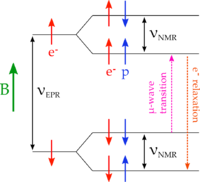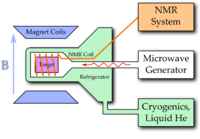Difference between revisions of "Practical Primer on the UVa Target"
(→Dynamic Nuclear Polarization) |
(→Magnetic Field) |
||
| Line 24: | Line 24: | ||
===Magnetic Field=== | ===Magnetic Field=== | ||
| − | The magnetic field is provided by a superconducting Helmholtz pair capable of producing 5T at great (10^-4) uniformity in a 3x3x3 cm^3 volume at the target cell. | + | The magnetic field is provided by a superconducting Helmholtz pair capable of producing 5T at great (10^-4) uniformity in a 3x3x3 cm^3 volume at the target cell. This magnet's open geometry allows for beam to pass at both parallel and perpendicular to the field. An Oxford Instruments power supply provides the necessary current (around 70A at 5T), and controls the modes of operation. |
| + | |||
| + | The two modes are ''connected'' and ''persistant''. A superconducting switch, which is simply a length of superconducting wire near a heater coil, changes these modes. In ''connected'', the switch is "opened" by heating the superconducting wire; this "connects" the magnet coils to the leads of the power supply. In ''persistant'' mode, the switch is allowed to cool; as the wire again becomes superconducting the relatively high resistance of the power supply leads makes it "invisible" to the current in the superconducting coils. | ||
| + | |||
| + | Magnet energization and de-energization may only be performed by a target expert. The ramp up and down must be carefully controlled to avoid losses in superconductivity called ''quenches''. | ||
====Shim Coils==== | ====Shim Coils==== | ||
Revision as of 15:09, 9 September 2011
Contents
Overview
Our Dynamically Nuclear Polarized Target can provide greater than 90% proton polarization in an irradiated ammonia target sample, in a 5T magnetic field and at around 1K. The basic operating principle involves leveraging the spin-spin coupling of a free electron in our material to the proton we wish to polarize. In a magnetic field, the spin-spin coupling results in a hyper-fine splitting, as seen in the diagram to the right.
Using microwaves of wavelengths corresponding to the energy gaps, transitions can be induced to flip the spin of the proton along with the spin of the electron. As in the example of the diagram, the (down,down) state can be flipped to the (up,up) aligned state, but by changing the microwave frequency it is also possible to flip the (down,up) state to the (up,down) state, thereby anti-aligning the proton without changing the magnetic field.
Since the relaxation time of the electron at 1K is on the order of milliseconds, compared to proton's tens of minutes, the same electron can be used to polarize many protons. The proton polarization travels away from the immediate vicinity of the free electrons via spin diffusion.
Thermal Equilibrium Polarization
The starting point for our technique is quite simple, but still crucial to the operation of the target. By placing our material in a high magnetic field B and at low temperature T, we can expect from Boltzmann statistics that our polarization when the material reaches thermal equilibrium should be:
If we assume a 5T field and 1K temperature, comes out to a proton polarization of around 0.3%. But we notice for electrons, whose magnetic moment is 660 times that of the proton, we have near 100% polarization.
While 0.3% proton polarization is obviously not practical, this starting point will provide a crucial point of calibration as we attempt to measure the polarization with NMR.
Dynamic Nuclear Polarization
To produce high proton polarization, we use the technique of Dynamic Nuclear Polarization (DNP), which we briefly outlined in the overview. There are 5 basic ingredients which go into this technique: a high magnetic field, a low temperature, a microwave system, an NMR system, and a suitable target material. We will briefly walk through these 5 building blocks, and what systems are necessary to provide them in the experimental hall.
Magnetic Field
The magnetic field is provided by a superconducting Helmholtz pair capable of producing 5T at great (10^-4) uniformity in a 3x3x3 cm^3 volume at the target cell. This magnet's open geometry allows for beam to pass at both parallel and perpendicular to the field. An Oxford Instruments power supply provides the necessary current (around 70A at 5T), and controls the modes of operation.
The two modes are connected and persistant. A superconducting switch, which is simply a length of superconducting wire near a heater coil, changes these modes. In connected, the switch is "opened" by heating the superconducting wire; this "connects" the magnet coils to the leads of the power supply. In persistant mode, the switch is allowed to cool; as the wire again becomes superconducting the relatively high resistance of the power supply leads makes it "invisible" to the current in the superconducting coils.
Magnet energization and de-energization may only be performed by a target expert. The ramp up and down must be carefully controlled to avoid losses in superconductivity called quenches.
Shim Coils
The uniform field region can be tuned using a set of shim coils, but in practice this is not necessary. However, leaving the shim coils superconducting while the main coils are being energize will lead to trouble. Unless the shims are held at zero current by their power supply, the current induced from the main coil's energization can result in shim quenches in which too much shim current causes a failure in superconductivity.


